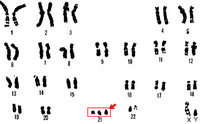Syndromes due to aneuploidy of autosomes
Aneuploidy refers to the loss (monosomy) or presence of (one or more) chromosomes in the genome of a cell. The cause may be a division disorder (nondisjunction) of homologous chromosomes in the I. maturation division or chromatids in the II. I see division.
Down's syndrome[edit | edit source]
We find the karyotype 47,XX or XY + 21 (trisomy of chromosome 21). Clinically described for the first time by Dr. by Langdon Down (1866), but molecularly by Lejeun (1959)
- incidence : 1:600 – 1:800 births
- significant dependence on the age of the mother at the time of delivery
- 65-70% of cases are detected prenatally in the Czech Republic and the number of unterminated pregnancies is increasing
Clinical picture[edit | edit source]
- pronounced muscle hypotonia in newborns
- brachycephaly
- broad, flat face, slanted eye slits, epicanths (skin folds, bridging the inner corner of the eye), broad nasal bridge, large tongue, and dental anomalies
- 50% of individuals palmar (monkey, four-fingered) grooves on the palms (in the normal population 2-3%)
- fingers are short and wide, little fingers are roll-shaped (clinodactyly) with a short middle link
- a wide gap between the first and second toes
- smaller figure, around 150 cm
- psychomotor retardation of varying degrees
- IQ is usually in the range of 25-75 , on average 40-45
- socially adaptable and thanks to better health care, they live to be 50-60 years old (ability to treat infections, cancer, congenital heart defects and developmental defects of other organs - they are prone to them and can be operated on today)
- in most adults later in life Alzheimer's disease - third dose effect of gene on chromosome 21 - gene for amyloid precursor protein
- fertility greatly reduced, especially in men
- cases of pregnancy more frequent in women , almost zero fertility in men
- the risk of the offspring of parents with Down syndrome being affected is difficult to determine due to the number, but there are also cases of healthy children
Types of Down syndrome[edit | edit source]
- simple trisomy of chromosome 21 (95%)
- translocation form of trisomy 21 (4-5%)
- trisomic and normal line mosaicism (1%) – individuals generally have milder manifestations of Down syndrome
Edwards syndrome[edit | edit source]
Karyotype: 47,XX or XY + 18 (trisomy of chromosome 18). The prognosis of individuals with trisomy 18 is poor, they rarely live for a few months to a year. 80% of affected individuals are female , boys generally have a lower chance of survival
- incidence: approximately 1:5000 live births
- directly related to the age of the mother
- most fetuses conceived in this way are spontaneously aborted
Clinical picture[edit | edit source]
- severe psychomotor retardation and failure to thrive
- congenital developmental defects of the kidneys and heart
- microcephaly and prominant headache
- receding chin, low-set malformed acorns
- the characteristic holding of the fingers in closed fists with the second finger crossed over the third and the fifth over the fourth
- nails tend to be hypoplastic
Patau syndrome[edit | edit source]
The karyotype is 47,XX or XY + 13 (trisomy of chromosome 13). It has the worst prognosis of the three syndromes – survival 1 month after birth at most.
- rarer occurrence – 1:10,000
Clinical picture[edit | edit source]
- severe mental and growth retardation
- severe CNS malformations, holoprosencephaly
- malformations of the eyes, which can merge into one or be completely absent
- craniofacial dysmorphia with severe cleft palate and lip
- earlobes malformed and low-set
- congenital heart and urogenital defects are present
- postaxial polydactyly of the upper and lower limbs
Links[edit | edit source]
Related articles[edit | edit source]
- Syndromes due to aneuploidy of gonosomes
- Chromosomal aberrations
- Numerical chromosomal aberrations
- Indications for karyotype examination
- Clinical genetics
Source[edit | edit source]
- ŠTEFÁNEK, Jiří. Medicína, nemoci, studium na 1. LF UK [online]. [cit. 11. 2. 2010]. <http://www.stefajir.cz>.


